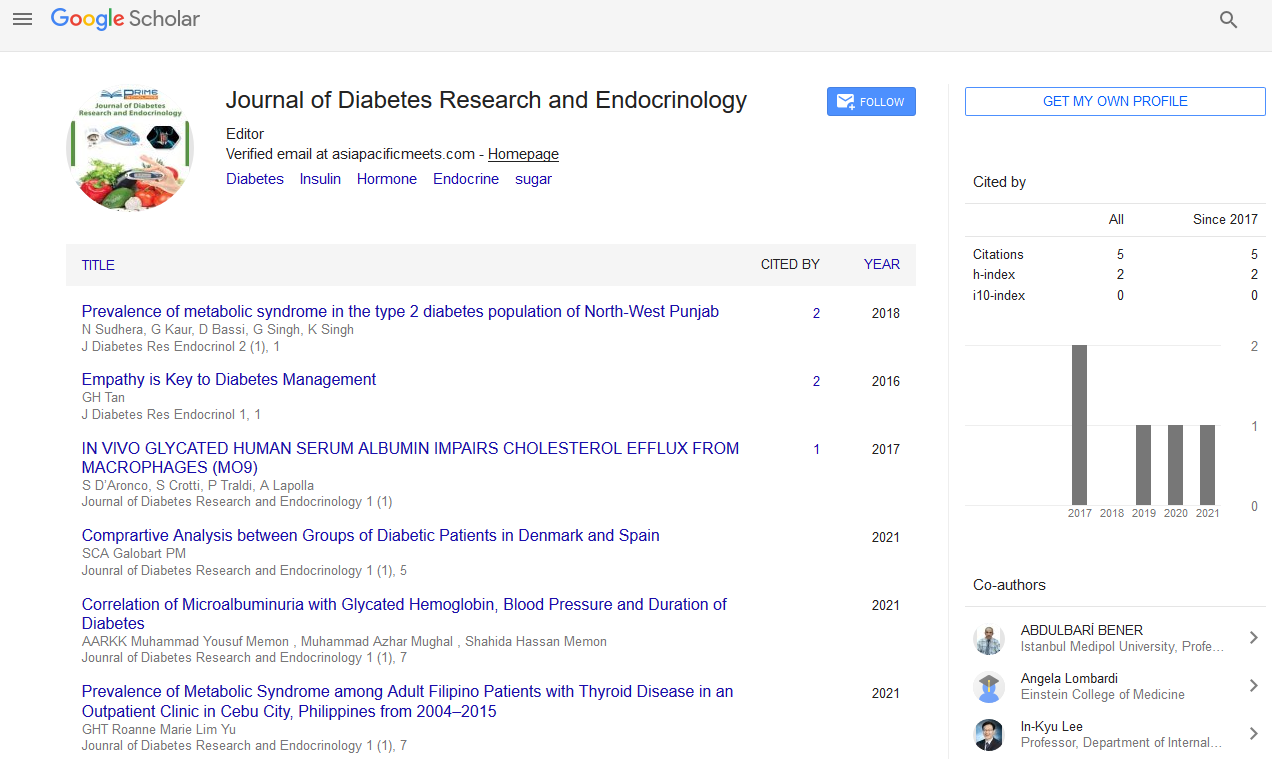Penelope Ferguson*
Department of Endocrinology, University of Tennessee Health Science, Tennessee, USA
- *Corresponding Author:
- Penelope Ferguson
Department of Endocrinology,
The University of Tennessee Health Science,
Tennessee,
USA,
E-mail: Ferguson.Penelope@ten-uni.org
Received Date: December 10, 2021; Accepted Date: December 24, 2021; Published Date: December 31, 2021
Citation: Ferguson P (2021) Abnormalities of Pathophysiologic in Diabetic Renal Disorder. J Diabetes Res Endocrinol Vol.5 No.S2: e002.
Description
Diabetic nephropathy is a common complication and it can
lead chronic loss of excretory organ operates occurring in those
with polygenic disorder mellitus. Diabetic nephropathy is one in
all the leading causes of chronic kidney disease (CKD) and end-
Autophagy is a highly conserved self eating pathway homeostasis
which cells degrade and recycle macromolecules and organelles
become massive, and cause an occasional albumen with ensuing
generalized body swelling (edema) and end in the nephrotic
syndrome. Likewise, the calculable capillary filtration rate (eGFR)
may more and more falls from a standard of over ninety ml/min/
1.73 mm to lower than 15, at that purpose the patient is alleged
to have end-stage excretory organ disease. it always is slowly
progressive over years.
Pathophysiologic abnormalities in diabetic renal disorder
begin with long-standing poorly controlled glucose levels. This is
often followed by multiple changes within the filtration units of
the kidneys, the nephrons. (There are ordinarily concerning
750,000–1.5 million nephrons in every adult kidney). Initially,
there's constriction of the neuromotor arterioles and dilation of
corticoafferent arterioles, with ensuing capillary changes high
blood pressure and hyperfiltration; this step by step changes to
hypofiltration over time. Concurrently, there are changes inside
the capillary itself: these include a thickening of the basement of
membrane, a widening of the slit membranes of the podocytes,
a rise within the variety of mesangial cells, and an increase in
mesangial matrix. This matrix invades the capillary capillaries
and produces deposits referred to as Kimmelstiel-Wilson
nodules. The mesangial cells and matrix will more and more
expand and consume the complete glomerulus, motion off
filtration.
The standing of diabetic renal disorder could also be
monitored by measurement 2 values: the number of
macromolecule in the micro-albuminuria; and a biopsy called
the blood serum creatinine. The number of the proteinuria
reflects the degree of harm to any still-functioning glomeruli.
the worth of the serum creatinine can be wont to calculate the
calculable capillary filtration rate (eGFR), that reflects the share
of glomeruli which Any longer filtering the blood. Treatment
with an Hypertensin changing protein substance or angiotensin
receptor blocker, which dilates the arteriola exiting the
glomerulus, so reducing the pressure inside the glomerular
capillaries, which can slow (but not stop) progression of the
disease. 3 categories of polygenic disorder medications GLP-1
agonists, DPP-4 inhibitors, and SGLT2 inhibitors–also are often
thought to slow the progression of diabetic renal disorder.
Diabetic nephropathy is that the commonest reason behind
end-stage excretory organ disease and is a serious complication
that affects more or less one quarter of adults with polygenic
disorder within the United States. Affected people with endstage
nephropathy usually need dialysis and eventually excretory
organ transplantation to interchange the unsuccessful kidney
function. Diabetic nephropathy is related to an inflated risk of
death in general, significantly from vas disease. The disease
progression of diabetic nephropathy involves varied clinical
stages: hyper filtration, micro albuminuria, macro albuminuria,
nephrotic albuminuria to progressive chronic kidney disease
resulting in end-stage excretory organ disease (ESRD). The harm
is exerted on all compartments of the kidney: the glomerulus,
the renal tubules, the vasculature (afferent and neuromotor
renal arterioles) and the interstitium excretory organ pathology
is that the final common pathway of DN. This fibrosis could be a
product of multiple mechanisms together with renal
hemodynamic changes, aldohexose metabolism abnormalities
related to aerobic stress still as inflammatory processes and a
hyperactive renin-angiotensin-aldosterone system (RAAS).
The pathophysiology of diabetic renal disorder is believed to
involve an interaction between hemodynamic and metabolic
factors. Hemodynamic factors embody a rise in general and
intraglomerular pressure, as well because the over-activation of
the RAAS. Studies have shown that within the setting of
diabetes, varied factors stimulate the RAAS that is one in all the
most necessary pathways in diabetic renal disorder
pathophysiology. The upper load of filtered aldohexose, there's
associate up-regulation within the atomic number 11-glucose
cotransporter a pair of (SGLT2) in the proximal tubules that
cotransports sodium and glucose back to circulation. This ends
up in a decrease in the delivery of binary compound to the
macula densa in the distal tubules, promoting the discharge of
peptidase and over-activating RAAS. Hyperfiltration is one in all
the earliest options of DN. many mechanisms are planned to
cause hyperfiltration. One in all these mechanisms is that as
glomeruli becomes hypertrophied, filtration area at first
increases. Another attainable mechanism is that abnormal
vascular management in diabetic renal disorder ends up in a
discount in corticoafferent capillary arterial blood vessel
resistance and a rise in neuromotor glomerular arteriolar
resistance, resulting in a internet increase in excretory organ
blood flow (RBF) and glomerular filtration rate (GFR) capillary
hyperfiltration and an aberrant regulation of RAAS cause
inflated intraglomerular pressure, inflicting stress on the
epithelium cells, the mesangial cells and therefore the
podocytes. This exacerbates the disfunction caused by the
metabolic effects of hyperglycemia.

